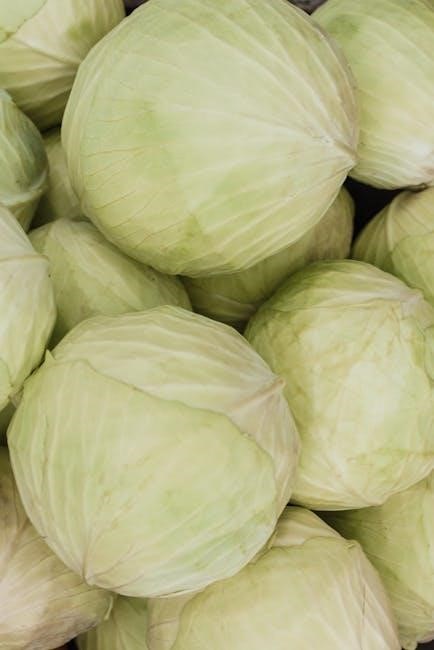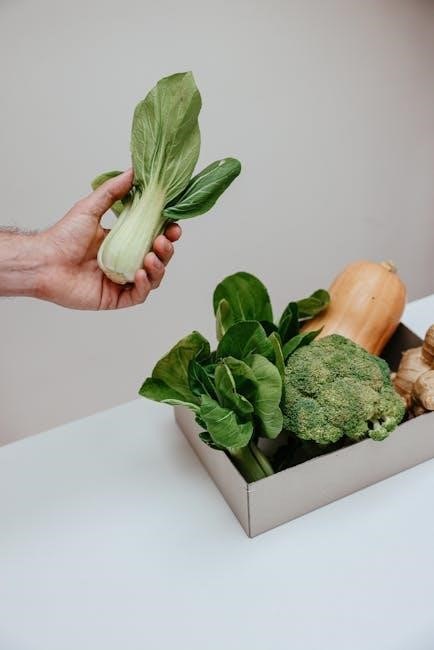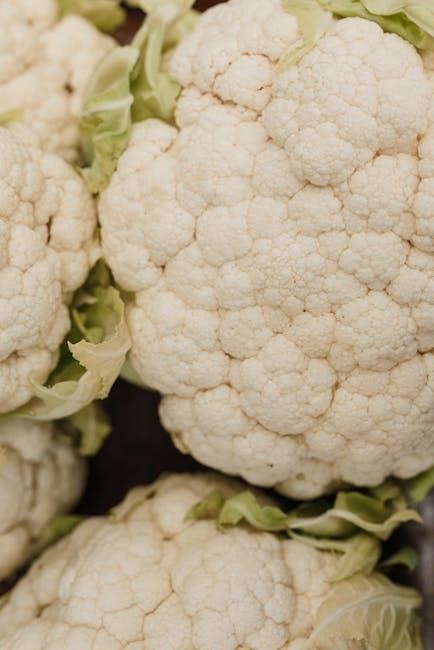Cruciferous vegetables belong to the Brassicaceae family, known for their distinctive four-petaled flowers․ They include broccoli, kale, Brussels sprouts, and more, offering exceptional nutritional value and health benefits․
Definition and Overview
Cruciferous vegetables are plants in the Brassicaceae family, characterized by their four-petaled flowers resembling a cross․ Common examples include broccoli, cauliflower, kale, and Brussels sprouts․ These vegetables are renowned for their vibrant flavors and exceptional nutritional profiles․ They are rich in vitamins, minerals, and phytochemicals, making them a cornerstone of healthy diets․ Often referred to as “crucifers,” they are versatile in culinary uses, from salads to main dishes․ Their name originates from the Latin word crux, meaning cross, due to the distinctive shape of their flowers․ These vegetables are widely recognized for their potential health benefits and are often recommended for their antioxidant and anti-inflammatory properties․
Importance of Cruciferous Vegetables in Nutrition
Cruciferous vegetables are essential in a balanced diet due to their high nutrient density․ They are rich in vitamins A, C, and K, along with minerals like calcium and potassium․ These vegetables also contain fiber, which supports digestion and gut health․ Their unique phytochemicals, such as glucosinolates, have been linked to antioxidant and anti-inflammatory properties, making them a key component of diets aimed at preventing chronic diseases․ Incorporating cruciferous vegetables into meals provides sustained energy, supports immune function, and promotes overall well-being․ Their versatility in recipes further enhances their role in maintaining a nutritious and varied diet․

Health Benefits of Cruciferous Vegetables
Cruciferous vegetables offer numerous health benefits, including reducing cancer risk and supporting heart health․ They are packed with antioxidants and fiber, promoting overall wellness and longevity․
Rich in Vitamins and Minerals
Cruciferous vegetables are rich in essential vitamins like C and K, and minerals such as calcium and potassium․ These nutrients support immune function, bone health, and blood clotting․ Regular consumption of these vegetables can help maintain optimal vitamin and mineral levels, contributing to overall well-being and disease prevention․ Their high nutrient density makes them a valuable addition to a balanced diet․ Incorporating cruciferous vegetables ensures adequate intake of these vital nutrients, promoting better health outcomes․ They are also a good source of folate, which is crucial for cell growth and development․ Eating a variety of these vegetables maximizes nutrient intake and supports long-term health benefits․
High Fiber Content
Cruciferous vegetables are an excellent source of dietary fiber, which plays a crucial role in digestive health․ High fiber content helps promote regular bowel movements, preventing constipation and supporting a healthy gut microbiome․ This can also contribute to better blood sugar control and satiety, aiding in weight management․ A diet rich in fiber from cruciferous vegetables may reduce the risk of chronic diseases, such as heart disease and type 2 diabetes․ Incorporating these vegetables into meals ensures a good fiber intake, fostering overall digestive well-being and long-term health benefits․ Their fiber content also supports healthy cholesterol levels, further enhancing cardiovascular health․
Cancer Prevention Properties
Cruciferous vegetables contain potent compounds like glucosinolates, which break down into isothiocyanates and indoles, offering strong cancer-fighting properties․ These compounds help detoxify carcinogens, inhibit cancer cell growth, and induce apoptosis in malignant cells․ Studies show that regular consumption of cruciferous vegetables may reduce the risk of colon, breast, prostate, and lung cancers․ Their antioxidants and anti-inflammatory effects further protect cells from damage, enhancing overall cancer prevention․ Incorporating these vegetables into a balanced diet is a proactive step toward lowering cancer risk and promoting long-term health․ Their unique phytochemical profile makes them a valuable addition to a cancer-preventive diet․
Complete List of Cruciferous Vegetables
Cruciferous vegetables include broccoli, kale, Brussels sprouts, cabbage, cauliflower, arugula, bok choy, radish, turnip, collards, horseradish, and mustard greens, among others․
Common Cruciferous Vegetables
Common cruciferous vegetables include broccoli, Brussels sprouts, cabbage, cauliflower, kale, and arugula․ These are widely available and often featured in various cuisines․ Broccoli and cauliflower are staples in many diets, while kale has gained popularity for its nutritional benefits․ Cabbage is versatile, used in salads, soups, and fermented dishes․ Brussels sprouts are a favorite roasted or sautéed, and arugula adds a peppery flavor to salads․ These vegetables are not only delicious but also packed with vitamins, fiber, and antioxidants, making them a healthy addition to meals․ Incorporating them into your diet is easy and beneficial for overall wellness․
Lesser-Known Cruciferous Vegetables
Beyond the familiar broccoli and kale, lesser-known cruciferous vegetables offer unique flavors and textures․ Bok choy, with its delicate taste, is ideal for stir-fries․ Collard greens, rich in nutrients, are often used in soups․ Mustard greens add a spicy kick to salads․ Kohlrabi, resembling a turnip, is crunchy and versatile․ Broccolini, a hybrid of broccoli and gai lan, has a milder flavor․ Horseradish, known for its pungent root, is a lesser-known member․ These vegetables are equally nutritious, providing vitamins, fiber, and antioxidants, making them valuable additions to a balanced diet․ Exploring these options can enhance meals with diversity and nutritional richness․
Culinary Uses of Cruciferous Vegetables
Cruciferous vegetables add versatility to various dishes․ They can be roasted, sautéed, steamed, or used raw in salads․ Incorporating them into meals enhances flavor, texture, and nutrition effortlessly․
Popular Recipes Featuring Cruciferous Vegetables
Cruciferous vegetables are a cornerstone in many delicious recipes․ Broccoli and cauliflower can be transformed into hearty soups, while Brussels sprouts and kale add a fresh touch to salads․ Roasted Brussels sprouts with garlic and lemon are a crowd favorite, offering a caramelized sweetness․ Arugula and radish make a peppery addition to vibrant green smoothies or as a bed for grilled meats․ Cabbage is a versatile ingredient in fermented dishes like sauerkraut or kimchi, while bok choy and rapini shine in Asian-inspired stir-fries․ These vegetables elevate any meal with their unique flavors and textures․
Tips for Incorporating Cruciferous Vegetables into Meals
Incorporate cruciferous vegetables into your diet with simple, tasty methods․ Add kale or spinach to smoothies for a nutrient boost․ Roasted Brussels sprouts with olive oil and seasoning make a delicious side dish․ Sauté broccoli or bok choy with garlic as a quick stir-fry․ Use shredded cabbage in salads or as a crunchy slaw․ Add arugula to pizzas or pasta for a peppery flavor․ Ferment cabbage or radish to create probiotic-rich dishes like sauerkraut or kimchi․ These versatile vegetables can elevate any meal, ensuring a healthy and flavorful diet․
Nutritional Profile of Cruciferous Vegetables
Cruciferous vegetables are rich in vitamins C and K, calcium, potassium, and antioxidants․ They contain fiber, supporting digestion, and phytochemicals like glucosinolates, which may aid in disease prevention․
Vitamins and Antioxidants
Cruciferous vegetables are packed with essential vitamins and antioxidants, including vitamin C, which boosts immunity, and vitamin K, crucial for blood clotting and bone health․ They also contain a wealth of antioxidants like kaempferol and quercetin, which help combat oxidative stress and reduce inflammation․ These compounds play a significant role in protecting cells from damage, potentially lowering the risk of chronic diseases․ The combination of vitamins and antioxidants in cruciferous vegetables makes them a powerful addition to a healthy diet, supporting overall well-being and longevity․
Minerals and Phytochemicals
Cruciferous vegetables are rich in minerals such as calcium, magnesium, and potassium, which support bone health and bodily functions․ They also contain sulfur compounds, like glucosinolates, which are converted into phytochemicals with potential anti-cancer properties․ These phytochemicals, including isothiocyanates and indoles, have been studied for their role in detoxification and protecting against cell damage․ The mineral and phytochemical content in cruciferous vegetables contributes to their reputation as a nutrient-dense food group, offering both nutritional and medicinal benefits while enhancing overall dietary balance and health outcomes․

How to Incorporcate Cruciferous Vegetables into Your Diet

How to Incorporate Cruciferous Vegetables into Your Diet
Add cruciferous vegetables like broccoli, kale, and Brussels sprouts to salads, stir-fries, and soups for a nutrient-rich, flavorful boost to your meals daily․
Meal Planning Ideas
Incorporate cruciferous vegetables into your meals by adding broccoli to omelets or stir-fries, using kale in smoothies or salads, and roasting Brussels sprouts as a side dish․ Try sautéing arugula with garlic for a quick garnish or blending cauliflower into soups for added nutrition․ Plan weekly meals by rotating vegetables like cabbage, bok choy, and radishes to ensure variety․ Pair them with lean proteins or whole grains for balanced dishes․ Experiment with seasonings to enhance flavors, making it easy to enjoy these vegetables throughout the day․ A diverse cruciferous diet supports overall health and culinary creativity․
Storage and Preparation Tips
Store cruciferous vegetables in the refrigerator to maintain freshness, keeping them dry to prevent spoilage․ Use breathable bags or containers to retain humidity without moisture buildup․ Before preparation, wash thoroughly under cold water and pat dry to remove excess moisture․ For cooking, roast, steam, or sauté to preserve nutrients and enhance flavor․ Overcooking can reduce nutritional value, so opt for gentle methods․ Consider massaging kale for better texture or blanching broccoli for vibrant color․ Proper storage and preparation ensure cruciferous vegetables remain nutritious and delicious, making them a versatile addition to any meal․

References and Further Reading
Explore scientific studies and detailed guides on cruciferous vegetables through resources like Healthline, Mary’s Herbs, and IARC Handbooks for comprehensive insights and research-based information․
Scientific Studies on Cruciferous Vegetables
Scientific studies highlight the health benefits of cruciferous vegetables, particularly their role in cancer prevention․ Research from the International Agency for Research on Cancer (IARC) and other organizations suggests that compounds like isothiocyanates and indoles in these vegetables may inhibit cancer cell growth․ Studies also emphasize their high fiber, vitamin, and mineral content, contributing to overall well-being․ Regular consumption of cruciferous vegetables has been linked to reduced risks of chronic diseases, making them a vital part of a healthy diet․ These findings are supported by extensive research published in scientific journals and health guides․
Recommended Resources for Learning More
For further exploration, visit reputable sources like Marysherbs and Healthline for detailed guides․ The National Cancer Institute also provides insights into their cancer-preventive properties․ Additionally, cookbooks and nutrition guides specializing in cruciferous vegetables offer practical meal ideas․ Websites like CAHFSa provide downloadable resources for comprehensive learning․ These platforms ensure access to accurate and up-to-date information, helping you make informed dietary choices and explore the full potential of cruciferous vegetables․
Cruciferous vegetables are essential for a healthy diet, offering versatility in meals and numerous health benefits․ Incorporate them into your routine for enhanced nutrition and well-being․
Final Thoughts on the Importance of Cruciferous Vegetables
Cruciferous vegetables are a cornerstone of a healthy diet, offering abundant vitamins, minerals, and antioxidants․ Their cancer-fighting properties and high fiber content make them indispensable; Regular consumption supports overall well-being and reduces chronic disease risks․ Incorporating varieties like broccoli, kale, and Brussels sprouts into meals is a simple yet impactful way to enhance nutrition․ These vegetables are versatile, nutritious, and essential for maintaining a balanced lifestyle․ Embrace their benefits and make them a staple in your diet for long-term health and vitality․
